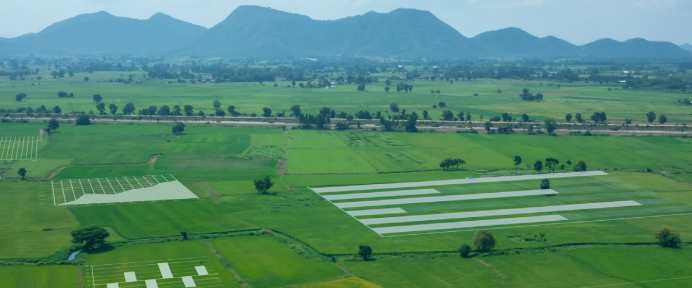Tapping into new practices and technologies to enhance sustainable agriculture for food security

Agriculture is critical to the African economy, accounting for 23% of GDP and 49% of direct employment. This means that the continent’s output must thrive and meet the demands of its growing population. However, agriculture is also a major part of the climate problem. It currently generates 19–29% of total greenhouse gas (GHG) emissions and has adverse effects on ecosystems and human health caused by releasing large volumes of manure, pesticides, antibiotics, and growth hormones into the environment. Without action, that percentage could rise substantially as other sectors reduce their emissions.
In relation to this crisis, the United Nations 2030 Agenda on Sustainable Development Goals (SDGs), dedicates SDG12 to ensuring sustainable consumption and production patterns in all countries. This SDG entails “the use of services and related products which respond to basic needs and bring a better quality of life while minimizing the use of natural resources and toxic materials as well as the emission of waste and pollutants over the life cycle of the service or product so as not to jeopardize the needs of future generations”. Unsustainable agriculture is also a barrier to achieving SDG3 and SDG5 because humans may be exposed to these potentially-toxic pesticides through the food they consume, resulting in adverse health effects.
Africa must maximize agricultural productivity to ensure food security and economic growth as well as technology as it is a crucial sector for many countries in the continent. And as the sector steadily moves towards a more technological advancement, Africa must embrace these practices for sustainable production and consumption:
Regenerative agriculture
This is a conservative and rehabilitative approach to food and farming systems that focus on topsoil regeneration, increasing biodiversity, improving the water cycle, enhancing ecosystem services, supporting bio sequestration, increasing resilience to climate change, and strengthening the health and vitality of farm soil. This agricultural practice aims to reverse climate change by restoring depleted soils. Land degradation in Africa negatively impacts nearly half of all productive land, affecting well over 650 million people in Africa. Although the agricultural sector contributes about 25% of all human-created GHG emissions, it also has a crucial role in ending the climate change crisis. How? Through practices such as conservation tillage, cover cropping, crop rotation, sustainable irrigation and regulated grazing. For example, ploughing and tilling break the soil structure and release a concentration of carbon dioxide into the atmosphere. By embracing low or no tilling, there is zero physical disturbance of the soil, and this increases soil health, boosts plant growth, and traps more carbon where it ought to be.
Aerial imagery
Aerial imagery involves using airborne technological devices to capture a geographical area. The image, often captured using a satellite or a low-altitude aircraft such as a plane or a drone, provides the user/farmer with prime information/data about the crops. The farmer analyzes and interprets the image data to help him manage his farm and identify changes.
Drones with specialised sensors alert farmers of changes like normalised difference vegetation index (NDVI), leaf area index, and photochemical reflectance index. The NDVI provides the farmer with information about water pressure, infestations, crop diseases, and nutrient deficiency, all of which can affect crop productivity. With the aid of a drone, farmers can also decide when pruning might be necessary by looking at the tree canopy from above.
On the continent, agritech companies like Aerobotics in South Africa and AcquahMeyer Drones in Ghana solve agricultural problems with aerial imagery. Aerobotics provide farmers with information to track trees, detect unhealthy ones, and act where needed. AcquaMeyer Amdrone Tech uses real-time observational technology and NDVI data to generate insights on water management, disease prevention and even warn farmers about potential problems. This is a perfect solution for a sustainable future.
Indoor vertical farming
Because arable lands are rapidly disappearing due to climate change and other factors, it has become necessary to develop a more sustainable crop-growing method. This involves growing crops in vertically built layers through soilless farming techniques such as hydroponics, aquaponics, and aeroponics.
Indoor vertical farming makes use of a nutrient tank. Nutrient solutions in the required quantities are dispensed to the tank from which the plants extract nutrients for growth. This farming technique requires no soil. Although about 60 per cent of the world’s uncultivated arable land is in Africa, farming on these arable lands doesn’t ensure food security or non-seasonal availability of agricultural produce. Farmers often have to battle with the adverse effects of climate change and rapid urbanisation therefore, this technique is ideal for ensuring food security, producing healthy crops, and meeting the growing urbanisation challenges. Agritech start-ups such as SFarmLab in Nigeria and Women Smiles in Uganda are already active in this space. Sack gardens are also used in Kenya as a local and practical form of a vertical farm.
Source: Agricultural trends in Africa 2022
There has been a rise in the demand for transition to a zero-carbon economy. While government action and global protests are a step in the right direction, world leaders have agreed that in order to avoid the most catastrophic climate change scenarios, average global temperature rise must not exceed 2°C above pre-industrial levels. However, this cannot be achieved by one entity, but efforts from all stakeholders including state organs, private sector and individuals. Let’s take action by creating awareness and investing in advanced technology to enhance sustainable agricultural farming in Kenya and for a sustainable future.

